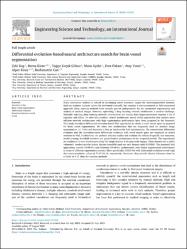Differential Evolution-Based Neural Architecture Search for Brain Vessel Segmentation

View/
Access
info:eu-repo/semantics/openAccessDate
2024Author
Kuş, ZekiKiraz, Berna
Göksu, Tuğçe Koçak
Aydın, Musa
Özkan, Esra
Vural, Atay
Kiraz, Alper
Can, Burhanettin
Metadata
Show full item recordCitation
KUŞ, Zeki, Berna KİRAZ, Tuğçe Koçak GÖKSU, Musa AYDIN, Esra ÖZKAN, Atay VURAL, Alper KİRAZ & Burhanettin CAN. "Differential evolution-based neural architecture search for brain vessel segmentation". Engineering Science and Technology, an International Journal, 46 (2024): 1-13.Abstract
Brain vasculature analysis is critical in developing novel treatment targets for neurodegenerative diseases.
Such an accurate analysis cannot be performed manually but requires a semi-automated or fully-automated
approach. Deep learning methods have recently proven indispensable for the automated segmentation and
analysis of medical images. However, optimizing a deep learning network architecture is another challenge.
Manually selecting deep learning network architectures and tuning their hyper-parameters requires a lot of
expertise and effort. To solve this problem, neural architecture search (NAS) approaches that explore more
efficient network architectures with high segmentation performance have been proposed in the literature.
This study introduces differential evolution-based NAS approaches in which a novel search space is proposed
for brain vessel segmentation. We select two architectures that are frequently used for medical image
segmentation, i.e. U-Net and Attention U-Net, as baselines for NAS optimizations. The conventional differential
evolution and the opposition-based differential evolution with novel search space are employed as search
methods in NAS. Furthermore, we perform ablation studies and evaluate the effects of specific loss functions,
model pruning, threshold selection and generalization performance on the proposed models. The experiments
are conducted on two datasets providing 335 single-channel 8-bit gray-scale images. These datasets are a public
volumetric cerebrovascular system dataset (vesseINN) and our own dataset called KUVESG. The proposed NAS
approaches, namely UNAS-Net and Attention UNAS-Net architectures, yield better segmentation performance
in terms of different segmentation metrics. More specifically, UNAS-Net with differential evolution reveals high
dice score/sensitivity values of 79.57/81.48, respectively. Moreover, they provide shorter inference times by
a factor of 9.15 than the baseline methods.


















